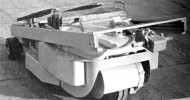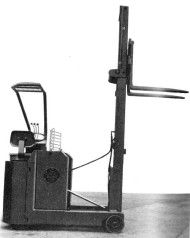 Warehouse & Logistics News is proud to bring you the forty-seventh instalment in our exclusive series on the history of the fork lift truck, the machine that over the decades has revolutionised the face of materials handling around the world.
Warehouse & Logistics News is proud to bring you the forty-seventh instalment in our exclusive series on the history of the fork lift truck, the machine that over the decades has revolutionised the face of materials handling around the world.
Our writer is James Brindley, an acknowledged authority on fork lift trucks. James’s distinguished career has involved engineering and management roles with BT Rolatruc and serving as a Director of the Fork Lift Truck Association, before he set up the National Fork Truck Heritage Centre in 2004 as Britain’s first such collection open to the public.
The Heritage Centre continues to need your support in 2010, and if you or your company would like to help in any way, you can contact James on the number below. Now sit back and enjoy the latest part of this fascinating series.
Episode 47: 1964: German demountable FLTs on show at Hanover
 In 1964, most types of West German mechanical handling equipment were only known about in Britain through agents and a few companies that manufactured here under licence. Their latest innovations were normally exhibited at their own Hanover Fair, held in the run up to the Earls Court Exhibition here in England. Sometimes, these ideas could take over a year or more to filter down into the British market, unless of course your company was large enough to afford the time and money to visit Hanover. This meant that unless the visiting UK press wrote about it, British industry was sometimes disadvantaged. One trade journal that tried to address this situation was the Mechanical Handling News but with such a large subject area to cover, not surprisingly the information supplied was brief.
In 1964, most types of West German mechanical handling equipment were only known about in Britain through agents and a few companies that manufactured here under licence. Their latest innovations were normally exhibited at their own Hanover Fair, held in the run up to the Earls Court Exhibition here in England. Sometimes, these ideas could take over a year or more to filter down into the British market, unless of course your company was large enough to afford the time and money to visit Hanover. This meant that unless the visiting UK press wrote about it, British industry was sometimes disadvantaged. One trade journal that tried to address this situation was the Mechanical Handling News but with such a large subject area to cover, not surprisingly the information supplied was brief.
One such innovation displayed at the 1964 Hanover Fair, which is so common on lorry transport today, was the demountable forklift. This was shown by three manufacturers, each machine having different features. The Wagner “Pick-a-Back” was a pedestrian, battery-operated stacker with a lifting capacity of 2,200 lbs. It was designed so the operator could remove and replace the machine on and off the rear of the transport trailer, using the forklift’s own power.
Jungheinrich displayed a similar machine of tubular construction. Both machines were designed so the forks, having been inserted into pockets in the rear of the lorry’s chassis, enabled them to be lifted clear of the ground.
The third machine, manufactured by Kottgen and Cie, used a different mount and dismount procedure. It was designed to be collapsed to a third of its normal size and be lifted into the stowage position by the lorry’s own tail lift.
 At the same show, Hans Still AG of Hamburg introduced a new type of front axle for their series 9 electric forklift trucks. The axle was designed to move forward 4.7 inches, giving the truck the necessary stability for travelling with a load. When retracted this allowed the truck’s length to become as short as possible and able to manoeuvre in a smaller space for the stacking operation. The trucks had a lifting capacity of 1,320 – 2,640 lbs to two standard lift heights of 134 inches and 138 inches.
At the same show, Hans Still AG of Hamburg introduced a new type of front axle for their series 9 electric forklift trucks. The axle was designed to move forward 4.7 inches, giving the truck the necessary stability for travelling with a load. When retracted this allowed the truck’s length to become as short as possible and able to manoeuvre in a smaller space for the stacking operation. The trucks had a lifting capacity of 1,320 – 2,640 lbs to two standard lift heights of 134 inches and 138 inches.
Back in Britain, during the latter part of 1964, the Lancer-Boss Group, founded by the Bowman Shaw brothers, opened a new factory in Leighton Buzzard. It brought their total production area up to 100,000 square feet and housed the entire production of Lancer sideloaders and Boss fork lift trucks. Eight production lines were employed in building 38 different models, and one line in particular was devoted entirely to trucks for the armed forces. All materialsthroughout the factory were handled by mobile equipment making the need for overhead cranes and other static equipment unnecessary. Even the large parts area, which occupied one third of the factory, and carried in excess of 8,000 spares was serviced by two electrically powered Lancer sideloaders.
 During October 1964, Lansing Bagnall gave details of a new gearbox that was to give improved performance to the FRER 3 Spacemaker reach truck. This feature was still a motor in wheel unit, but had an improved 2.6 h.p. shunt wound motor. The entire unit was made up of three main assemblies: a drive motor with turntable bearing, a gyral gearbox and a 15 inch x 5 inch drive wheel. Renamed the FRER 3.1, there were also other improvements made to the strength of chassis and reach channels.
During October 1964, Lansing Bagnall gave details of a new gearbox that was to give improved performance to the FRER 3 Spacemaker reach truck. This feature was still a motor in wheel unit, but had an improved 2.6 h.p. shunt wound motor. The entire unit was made up of three main assemblies: a drive motor with turntable bearing, a gyral gearbox and a 15 inch x 5 inch drive wheel. Renamed the FRER 3.1, there were also other improvements made to the strength of chassis and reach channels.
To be continued
By James Brindley, Director, National Fork Truck Heritage Centre.




Comments are closed.